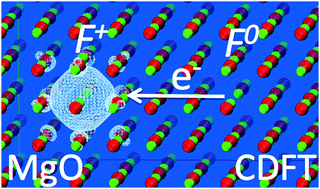Constrained density functional theory applied to electron tunnelling between defects in MgO†
Abstract
We employ a periodic plane-wave implementation of constrained density functional theory to describe electron tunnelling between oxygen vacancy defects in MgO. We find that calculated electron transfer parameters, and therefore electron tunnelling rates, depend sensitively on the fraction of Hartree–Fock exchange (HFX) used to approximate the exchange–correlation functional. In particular, we show that the exponential decay constant for electronic coupling (β) is proportional to the square-root of the band gap of MgO. Therefore, it is essential to use an exchange–correlation functional which predicts the correct band gap for accurate prediction of electron tunnelling rates. We also present a scheme for the correction of finite size effects for electronic coupling due to the interaction with periodic images, and discuss the sensitivity of the results with respect to the charge constraint used. The computationally demanding calculations presented in this work have only become feasible owing to recent advances in both computer hardware and code parallelisation and demonstrate that the first principles modelling of long-range

- This article is part of the themed collection: Charge transfer: experiment, theory and computation

 Please wait while we load your content...
Please wait while we load your content...